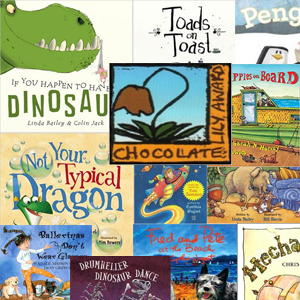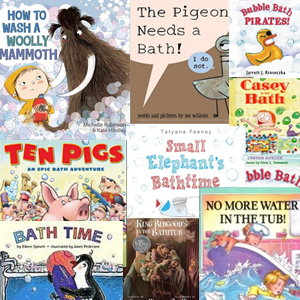 |
Celebrate Diwali : With Sweets, Lights And Fireworks Heiligman, Deborah As part of the “Holidays Around the World” series by National Geographic, the author Deborah Heiligman, along with her consultant Dr. Vasudha Narayanan, cooperatively presents the reader with an insider’s view of a colorful and joyous holiday known as Diwali and celebrated by people of the Hindu, Sikh, and Jain faiths with sweet treats, lots of lights, and loud, booming fireworks. Diwali, known as the Festival of Lights, is a traditional holiday that celebrates the victory of good over evil. Pictures of traditional clothing and food, celebrations with colors, lights, and more come alive on each page. The holy River Ganga, along with other beautifully represented areas of India, such as the Golden Temple in Amritsar is included in the Diwali traditions. The photographs encourage the reader to take a pictorial trip around the world where Diwali is celebrated in places such as Bethesda, Maryland, and Durban, South Africa. The reader will learn that just as in all other holidays, this is a time to visit with and honor family and friends. Presented through a rich blend of text and photographs, this fascinating cultural, historical, and religious celebration is clearly a treasure for all who believe in the triumph of good over evil. 2008, National Geographic Society, $6.95. Ages 4 to 8. REVIEWER: Melissa Stickles (Children’s Literature) ISBN(s) : 9781426302916 |
 |
The Story Of Divaali Verma, Jatinder Nath Divaali, the Hindu festival of lights, is celebrated in modern India much as Christmas is here. This story comes from The Ramayana, and Verma’s strong retelling is based on the versions told to him by his parents. The rich and complex tale of love and devotion includes a wicked stepmother, a devoted brother, a selfless princess, deception, filial piety, and patience. The god Vishnu sends Rama to be the prayed-for son of King Dashratha; Rama wins the hand of the Princess Sita by shooting a bow that he alone can handle. Adventure follows: the couple is banished, Sita is captured by a demon king and is rescued by Rama with the help of his brother and a monkey god. When Rama and Sita are restored to their kingdom, the people rejoice by lighting small oil lamps (diva) in all the windows, as if the stars had moved to earth. Gouache illustrations use blues, golds, and white: Vishnu and Rama are blue, as is traditional, and strong, sinuous lines enfold the colors in a glory of movement on the page. Category: Books for the Young–Nonfiction. 2002, Barefoot, $16.99. Gr. 1-3. REVIEWER: GraceAnne DeCandido (Booklist) (Additional reviews and awards available on CLCD.) ISBN(s) : 1841489360, 9781841489360 |
 |
Diwali : The Hindu Festival Of Lights, Feasts, And Family Parker-Rock, Michelle Part of the series, “Finding Out About Holidays” this title opens with a brief retelling of the dominant north Indian story behind Diwali. The summary of the story accurately reflects the Hindu epic, The Ramayana. However, the accompanying artwork is culturally dissonant from Indian images of the story. Parker-Rock does her best with the explanation of the first Diwali–a difficult task when dealing with a religion so old it has neither known founders nor a consistent chronology. The chapter fails to mention the major southern explanation of Diwali. The multiplicity and apparent mutual contradictions among Hindu traditions is admittedly confusing to the outsider, but it is regretful that the confusion is all too evident here. Overviews of Hinduism, preparations for the festival of Diwali, and accounts of the day itself, are adequate. Pronunciation keys in the text contain numerous mistakes. The most egregious error, however, is the selection of the photo on page 24. The caption reads, “On Diwali, many people show their respect for this day at temples.” The image, however, is of a bearded gentleman, roza (Muslim prayer beads) in hand, against the gorgeous trellis wall of what is indisputably a mosque! After ten years of calls for authenticity in multicultural books, this extent of generalization and conflation is a disgrace. Diwali is full enough of misinformation and misrepresentation that it ought not to be used in classrooms. 2004, Enslow, $18.95. Ages 7 to 10. REVIEWER: Uma Krishnaswami (Children’s Literature) (Additional reading measurement program info available on CLCD.) ISBN(s) : 0766022358, 9780766022355 |
 |
Festival Of Light : Deepavali Legends From Around India Radhika Sekar Radhika Sekar is an Indian-born Canadian with a background in religious studies focussing on Hinduism. She has published several books in an effort to introduce some of her culture to children. The books are large soft covers illustrated in a traditional Indian style. Festival of Light, illustrated by Katherine E. Allen, consists of seven stories associated with Deepavali, or Diwali, “a popular Hindu festival celebrated by all Hindus, irrespective of sect or caste.” The tales are told in folkloric cadence, but they are somewhat long and involved for those who discovering the characters for the first time. In “The Slaying of Ravana and the Return of Prince Rama,” readers learn of the heroism of Rama in rescuing the lovely Sita from wicked Ravana, a many-headed asura, or ogre. Rama explained how Ravana had tricked them and carried away Sita. “She must be rescued, but alas, we have no army. How can we fight the mighty Ravana?” Calling all the monkeys of the forest together, Hanuman replied, “Don’t be discouraged, dear Prince. We will help you. Our monkey army will gather stones and make a bridge across the sea to Lanka.” The defeat of Ravana comes not by severing his heads from his body but by striking the seat of his power, his belly. While the effort to make Hindu mythology accessible to young people is appreciated, it is not entirely unique. Other collections available, such as The Puffin Book of Classic Indian Tales (from Penguin Books India) and Indian Children’s Favourite Stories (Tuttle), while not dealing exclusively with Hindu lore, do cover some of the same material and are also illustrated in a style echoing classical Indian art. Indian Tales: a Barefoot Collection, previously reviewed in CM, covers India by region and prefaces each story with a summary of customs, food and holiday observances. The pictures in this book are a more in the western style. The books by Sekar are recommended for larger folklore collections, or for areas where there is an Indian population interested in Hindu lore. Recommended. Rating: ** /4. Grades 2-5. 2007, Vakils Feffer & Simons, 66 pp., pbk., $15.00. Ages 7 to 10. REVIEWER: Ellen Heaney (CM Magazine) ISBN(s) : 8187111704, 9788187111702 |
 |
Divali Powell, Jillian The “Why is This Festival Special?” series, originally published in the UK (hence the use of the term “festival” to be synonymous with “holiday”), also includes books about Christmas, Hanukkah, and Id-ul-Fitr. This title examines the importance of Divali, the Hindu festival of lights, and tells readers how it is celebrated. The opening chapter deals with beliefs related to the celebration and the prevalence of its observance on the Indian subcontinent. It is followed by a chapter presenting information about the mythological background, with an emphasis on the north Indian association of the story with the prince Ram and his return from exile. Subsequent chapters address the symbolism and use of lights, in particular oil lamps and candles, getting ready for Divali, dressing up, prayers, the association of the day with luck and money, shopping and public entertainment, special festive foods, and fireworks and dancing. A final chapter explains how Sikhs and Jains have incorporated this major Indian festival into their traditions as well. Fully illustrated with color photographs, this book is clearly and respectfully developed for younger readers. Quotes from practicing Hindus constitute an addition to the narrative. A glossary, background information on the religions in this book, and an index round out the book. 2005, Franklin Watts, $25.65. Ages 7 to 10. REVIEWER: Uma Krishnaswami (Children’s Literature) (Additional reading measurement program info available on CLCD.) ISBN(s) : 9781583409466, 1583409467 |
 |
Diwali : Hindu Festival Of Lights Preszler, June Part of the publisher’s “Holidays and Cultures” set in the “First Facts” series, this volume is one of six being released simultaneously. The other titles are Christmas: Season of Peace and Joy, Juneteenth: Jubilee for Freedom, Passover: Jewish Celebration of Freedom, St. Patrick’s Day: Day of Irish Pride, and Thanksgiving Day: A Day of Thanks. The history and meaning of Diwali is explained briefly, in simple language accessible to the targeted K-3 audience. Customs and rituals are discussed, such as the ephemeral floor art form of rangoli and the lighting of firecrackers. Customs from north and south India are somewhat conflated. The identification of Diwali with the “Hindu New Year” is made to seem more of a pan-Indian observance than is actually the case. The rangoli pattern shown in the photographs is a powder design while the text describes another style, using paste. Back matter includes a sample rangoli design, a glossary, addition readings (one is a title containing significant errors), a password and instructions to access the FactHound web site, and an index. While the author has clearly done the work of simplifying this material for young readers, the perpetuation of minor errors in this volume could have easily been avoided. It is recommended that for future books with South Asian content, the publisher consult with someone knowledgeable not only about the region, but about the range of children’s books seeking to represent it. 2007, Capstone Press, $21.26. Ages 5 to 8. REVIEWER: Uma Krishnaswami (Children’s Literature) (Additional reading measurement program info available on CLCD.) ISBN(s) : 9780736863957, 0736863958 |
 |
The Divali Story Ganeri, Anita This story is part of the Hindu epic, The Ramayana, and underlies the celebration of Divali, an annual holiday in India. Although Rama is heir to the throne, he and his bride Sita are banished to the forest for fourteen years at the insistence of his step-mother. Lakshman, Rama’s brother, accompanies them. While the two men are hunting, Sita is abducted by Ravana, the demon king of Lanka. Rama and Lakshman are aided in the rescue by the monkey army with their general Hanuman, who is also the son of the god of the wind. Heavy paper and large print interspersed with exotic colored pictures enhance this retelling. Rama appears in traditional blue skin. Hanuman and his cohorts are appealingly human. There is a note about Divali celebrations and a note of explanation about The Ramayana. A recipe for making coconut candy and illustrated directions to make a Hanuman mask are included. This is part of the “Storyteller” series. Children and their parents will enjoy reading this classic Hindu tale in this durable edition. 2007 (orig. 2003), Cherrytree Books, $11.90. Ages 5 to 8. REVIEWER: Carlee Hallman (Children’s Literature) (Additional reading measurement program info available on CLCD.) ISBN(s) : 1842344331, 9781842344330 |
 |
How And Why Do Hindus And Sikhs Celebrate Divali? Mead, Jean How and why do Hindus and Sikhs celebrate Divali? is another title in the ‘Step-up Religion’ series written to encourage a deeper understanding of world religions amongst the younger generation. It is also aimed at Key Stage two to support the learning objectives of the religious education scheme of work curriculum. The text provides information about Divali, the festival of light, a Hindu festival celebrated in India for centuries. This festival is also celebrated by the followers of a different and much younger religion, Sikhism. The book first examines in detail all the aspects of Divali including the basic story, the deities worshipped and traditions and customs observed. It then discusses the significance of light and draws on other religions to broaden pupils’ perception of other faiths. Regarding why and how Sikhs celebrate Divali, the book briefly examines the religion and then provides a historical perspective to this tradition. The sixth Guru, Guru Har Gobind, was imprisoned for a considerable length of time and finally released on Divali in 1619. Sikhs illuminated the Golden Temple to welcome him. Since then Sikhs have joined Hindus in celebrating Divali but follow their own separate beliefs and practices along with some of the common traditions already established. Divali is a colourful festival and the illustrations in the book mirror this. Extensive notes for teachers and parents are given with a comprehensive glossary and index. ‘Step-up Religion’ Category: 8-10 Junior/Middle. Rating: 3 (Good). Evans, 32pp; NON FICTION, 12.99 hbk. Ages 8 to 10. REVIEWER: Khalida Alvi (Books for Keeps) ISBN(s) : 0237534126, 9780237534127, 0140155899842 |
Diwali: Celebrating Light
 |
Diwali is the “festival of lights,” the most important holiday of the Hindu year. It is a national holiday in India and a number of other countries, and is also celebrated adherents of other faiths. Oil lamps, fireworks, and strings of electric lights are lit to celebrate the triumph of light over darkness, which symbolizes the triumph of good over evil and knowledge over ignorance. This year, Diwali will be celebrated on October 23.
In recognition of Diwali, we offer TWO book lists: The first list below is a collection of books specifically about Diwali (alternately Divali, Divaali, or Deepavali). The second list is a selection of non-fiction, fiction, and poetry books that explore light from both scientific and artistic points of view. |
More Diwali Resources:
For general information, see: http://kids.nationalgeographic.com/kids/stories/peopleplaces/diwali/
For more details, see: http://www.diwalifestival.org/
Hinduism Today magazine offers a nice printable PDF that would make a nice flyer or poster to accompany a Diwali book display: http://www.hinduismtoday.com/pdf_downloads/pagers/Hindu-Festival_Diwali_broadsheet-color.pdf
Contributor: Andy Spinks
Books about Diwali
|
|
Books about Light
|
















